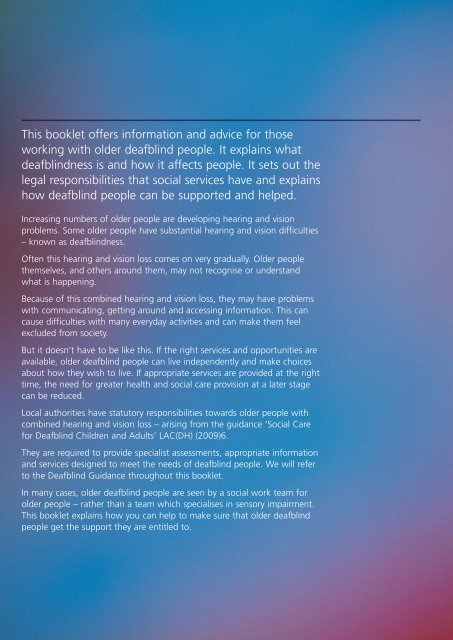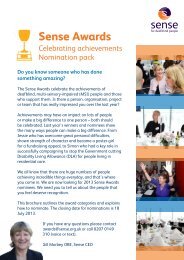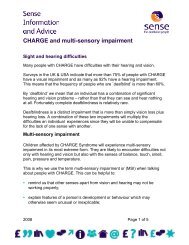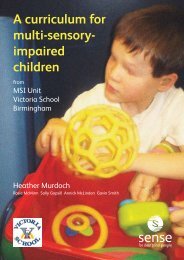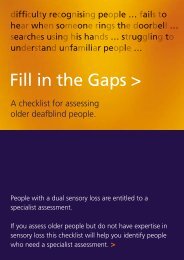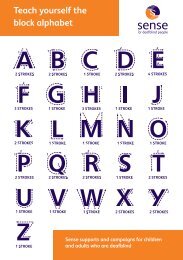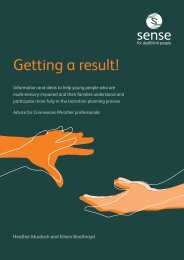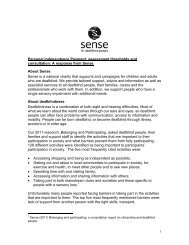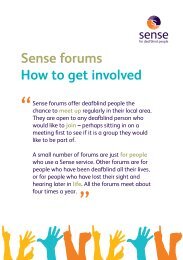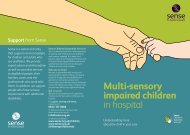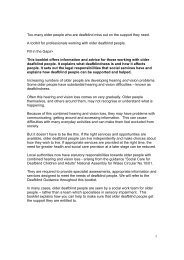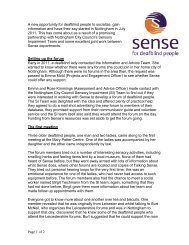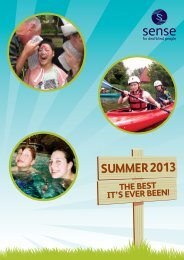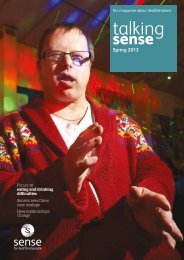Fill in the Gaps > Too many older people who are deafblind ... - Sense
Fill in the Gaps > Too many older people who are deafblind ... - Sense
Fill in the Gaps > Too many older people who are deafblind ... - Sense
You also want an ePaper? Increase the reach of your titles
YUMPU automatically turns print PDFs into web optimized ePapers that Google loves.
This booklet offers <strong>in</strong>formation and advice for thosework<strong>in</strong>g with <strong>older</strong> deafbl<strong>in</strong>d <strong>people</strong>. It expla<strong>in</strong>s whatdeafbl<strong>in</strong>dness is and how it affects <strong>people</strong>. It sets out <strong>the</strong>legal responsibilities that social services have and expla<strong>in</strong>show deafbl<strong>in</strong>d <strong>people</strong> can be supported and helped.Increas<strong>in</strong>g numbers of <strong>older</strong> <strong>people</strong> <strong>are</strong> develop<strong>in</strong>g hear<strong>in</strong>g and visionproblems. Some <strong>older</strong> <strong>people</strong> have substantial hear<strong>in</strong>g and vision difficulties– known as deafbl<strong>in</strong>dness.Often this hear<strong>in</strong>g and vision loss comes on very gradually. Older <strong>people</strong><strong>the</strong>mselves, and o<strong>the</strong>rs around <strong>the</strong>m, may not recognise or understandwhat is happen<strong>in</strong>g.Because of this comb<strong>in</strong>ed hear<strong>in</strong>g and vision loss, <strong>the</strong>y may have problemswith communicat<strong>in</strong>g, gett<strong>in</strong>g around and access<strong>in</strong>g <strong>in</strong>formation. This cancause difficulties with <strong>many</strong> everyday activities and can make <strong>the</strong>m feelexcluded from society.But it doesn’t have to be like this. If <strong>the</strong> right services and opportunities <strong>are</strong>available, <strong>older</strong> deafbl<strong>in</strong>d <strong>people</strong> can live <strong>in</strong>dependently and make choicesabout how <strong>the</strong>y wish to live. If appropriate services <strong>are</strong> provided at <strong>the</strong> righttime, <strong>the</strong> need for greater health and social c<strong>are</strong> provision at a later stagecan be reduced.Local authorities have statutory responsibilities towards <strong>older</strong> <strong>people</strong> withcomb<strong>in</strong>ed hear<strong>in</strong>g and vision loss – aris<strong>in</strong>g from <strong>the</strong> guidance ‘Social C<strong>are</strong>for Deafbl<strong>in</strong>d Children and Adults’ LAC(DH) (2009)6.They <strong>are</strong> required to provide specialist assessments, appropriate <strong>in</strong>formationand services designed to meet <strong>the</strong> needs of deafbl<strong>in</strong>d <strong>people</strong>. We will referto <strong>the</strong> Deafbl<strong>in</strong>d Guidance throughout this booklet.In <strong>many</strong> cases, <strong>older</strong> deafbl<strong>in</strong>d <strong>people</strong> <strong>are</strong> seen by a social work team for<strong>older</strong> <strong>people</strong> – ra<strong>the</strong>r than a team which specialises <strong>in</strong> sensory impairment.This booklet expla<strong>in</strong>s how you can help to make sure that <strong>older</strong> deafbl<strong>in</strong>d<strong>people</strong> get <strong>the</strong> support <strong>the</strong>y <strong>are</strong> entitled to.3


